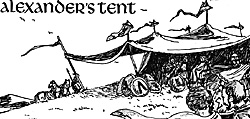
I received a fair number of responses from the first Alex's Tent. However, most of these I can't print because the writers missed the point. Let me quote from the earlier Alex's Tent; "When you submit an answer to a question, give a short summary of your findings, and specific sources. The sources are necessary to add credibility to your answer, and to give the rest of us a guide for further research." Sending sources with your answers is the key. If you want to send me your opinions on a question, please feel free to do so because I enjoy reading them. But with few exceptions I will not print those opinions unless they are based upon extrapolation of historical sources, sources you are willing to identify to the rest of us. But please keep those cards and letters coming.
ANSWERS TO EARLIER QUESTIONS
IV. Question 1. Were the later legion formations a tactical copy of Hannibal's formation?
An Answer. It is my opinion, based upon the writings of Graham Webster, THE ROMAN IMPERIAL ARMY, that the typical Carthaginian formation of an infantry center with the cavalry posted on the wings was not adopted, nor the 'phalanx' formation, still in general use, in all battles. As an example, Scipio's use of the legionaries on the flanks at the battle of I lipa in Spain. Polybius attributes the invention to the same Scipio during his Spanish campaign. (M. Carr, IA)
V. Question 2. Was the four-horse chariot used as a shock weapon or a troop transport in Near Eastern warfare?
An Answer. As a shock weapon. Assyrian Chariot crew are depicted (where?) dismounted only at sieges. (P. Barker, England)
V. Question 4. Arrian's Array shows indirect fire. Does the effect warrant inclusion in ancient rules?
An Answer. It doesn't. The two knolls at either end of Arrian's line were connected by a gentle saddle. The archers were still uphill of the intervening troops. (P. Barker, England)
An interesting idea. I can't prove there wasn't a saddle, but at this point you haven't proven that there was. One other part of the Arrian article would seem to support indirect fire: "Let it (the Roman Army) stand in silence, so that the right flank may raise a great and fearful war cry when the enemy is advancing within missile range." One of several reasons the right flank gives its cry is to let the indirect fire archers know when to shoot. - Ed.
Another Answer. Although the physical... significance would be small in a pitched battle, the psychological effect would be quite real. It would be utterly frustrating to be shot at by some cowardly archers, and yet not be able to get at them... The fear of that'one arrow with you r name on it'wou Id be a big factor with irregulars or levies. A proven example of indirect fire winning a battle would be the Battle of Hastings, 1066 AD. Harold Godwineson's men held off the Normans all day, but one arrow hit the ill-fated British monarch in the eye; morale went to zero P.D.Q. I rest my case. (M. Carr, IA)
I am not sure of the Hastings example being indirect fire as we define it here - which is shooters not having line of sight with their target. it is an example of the morale effect of a leader falling, and this morale effect is included in most rules. If it is indirect fire as we define it, please write back and let us know your sources.
Are there other examples that prove or disprove indirect fire? - Ed.
VI. Question 2. What types and sizes of horses were available to the ancients as compared to modern times?
An Answer. Varied according to Nation. Most ancient breeds can be regarded as identical to their modern descendents. Only the modern thoroughbred and large working breeds like Clydesdales did not then exist. Surviving cataphract horse armour fits a horse around 15.2 hands. Roman cavalry horse skeletons from Newstead are identical to modern Welsh Mountain ponies showing Arab characteristics and allegedly descending from them, and are around 14.2 hands. (P. Barker, England)
NEW QUESTIONS
1. HISTORY/CHRONOLOGY
1. When were the Franks first used in large numbers as Foederati by the Late Romans? (B. Rogers, I L)
III. LOGISTICS
III. ENGINEERING/FORTIFICATIONS/SlEGECRAFT
IV. UNIT ORGANIZATION AND TACTICS
1. Was the primary Avar tactic skirmishing bowfire like most Asiatic tribes or was it shock cavalry because of their lance and horse armor? (R. Marietta, NY)
V. OPERATIONAL DOCTRINE
VI. WEAPONS AND EQUIPMENT
3. Other than the WRG book, where can I find out more about theSaka in their wars against the Bactrian Greeks and Indians? I am mainly interested in weapons, armor, and tactics. (B. McCleary, CA)
VII. INSIGNIA AND UNIFORMS
VIll. MISCELLANEOUS
1. Who were the Arrians? Where did they originate and what did they look like? What was their influence concerning ancient India? (L. McKenzie, TX)
Back to Table of Contents -- Courier Vol. V #5
To Courier List of Issues
To MagWeb Master Magazine List
© Copyright 1984 by The Courier Publishing Company.
This article appears in MagWeb (Magazine Web) on the Internet World Wide Web.
Other military history articles and gaming articles are available at http://www.magweb.com